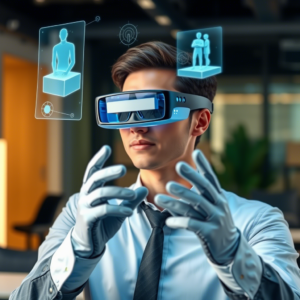
As number 5 we have Extended Reality (XR)—encompassing Augmented Reality (AR), Virtual Reality (VR), and Mixed Reality (MR)— that is revolutionizing the way we interact, learn, and work. By blurring the lines between the physical and digital worlds, XR is enhancing experiences across various sectors, from gaming and education to healthcare and retail. As we enter 2025, XR is transitioning from a futuristic concept to a practical tool that drives innovation and engagement. In this blog post, we explore why XR remains a critical technology to watch, the advancements expected in 2025, notable real-world implementations, and the significant value it offers to both businesses and individuals.
Strategic importance in 2025
XR’s strategic importance in 2025 is highlighted by its shift from novelty to necessity across numerous industries. As XR devices become more affordable and technologically advanced, businesses are increasingly leveraging them for immersive training, enhanced customer experiences, and remote collaboration. The growing narrative around the metaverse further propels XR into the spotlight, positioning it as a key player in redefining digital interactions and experiences. This widespread adoption underscores XR’s role in driving engagement, productivity, and innovation, making it an essential technology for businesses aiming to stay competitive in a rapidly evolving digital world.
Notable advancements and innovations
 In 2025, XR technology is set to achieve significant advancements that enhance its practicality and accessibility. XR hardware will become lighter, more affordable, and more intuitive, encouraging broader adoption. Companies are investing in AR glasses like Microsoft HoloLens 2, making them viable tools for frontline workers by providing hands-free access to information and streamlined workflows. VR headsets such as Meta Quest 3 will offer wireless freedom and ultra-high-resolution displays, improving user comfort and experience. Additionally, platforms like NVIDIA Omniverse are enabling businesses to create collaborative virtual environments, facilitating everything from design and simulation to remote teamwork, thereby expanding XR’s applicability and impact.
In 2025, XR technology is set to achieve significant advancements that enhance its practicality and accessibility. XR hardware will become lighter, more affordable, and more intuitive, encouraging broader adoption. Companies are investing in AR glasses like Microsoft HoloLens 2, making them viable tools for frontline workers by providing hands-free access to information and streamlined workflows. VR headsets such as Meta Quest 3 will offer wireless freedom and ultra-high-resolution displays, improving user comfort and experience. Additionally, platforms like NVIDIA Omniverse are enabling businesses to create collaborative virtual environments, facilitating everything from design and simulation to remote teamwork, thereby expanding XR’s applicability and impact.
High-impact example implementations
XR is already making substantial inroads across various industries with high-impact implementations. In manufacturing, companies like Boeing utilize AR to guide technicians through complex assembly tasks, reducing errors and training time significantly. In the retail sector, IKEA Place allows customers to visualize furniture in their homes using AR apps, enhancing the shopping experience and aiding in decision-making. Healthcare is also benefiting from XR, with platforms like Osso VR providing surgeons with lifelike training simulations, improving surgical skills and patient outcomes. These implementations demonstrate XR’s versatility and its ability to drive efficiency, enhance experiences, and foster innovation across different sectors.
Value to business and society
Extended Reality offers immense value to both businesses and society by creating immersive and interactive experiences that boost engagement and productivity. For businesses, XR enables the creation of engaging training programs that reduce costs and improve employee preparedness. Walmart, for example, uses VR to train employees in customer service and emergency scenarios, ensuring they are well-equipped to handle real-world challenges. In real estate, platforms like Matterport allow for virtual property walkthroughs, saving time for both buyers and sellers by providing a comprehensive view of properties without the need for physical visits.
On a societal level, XR is transforming education and accessibility. Educational applications like zSpace provide interactive 3D learning experiences, making STEM subjects more engaging and effective for students. XR also enhances accessibility by enabling individuals with disabilities to interact with their environment in new ways, improving their quality of life. Additionally, XR is revolutionizing entertainment and social interactions, offering immersive experiences that blend the digital and physical worlds seamlessly.
Strategic advice for leaders
To effectively leverage XR, business leaders should begin by identifying areas where immersive technology can create tangible value, such as training, design, or customer engagement. Partnering with established XR platforms like Unity or NVIDIA Omniverse can facilitate the development of tailored XR applications that meet specific business needs. Additionally, investing in user-friendly experiences is crucial to ensure seamless adoption among employees and customers. By focusing on these strategic areas, leaders can harness the full potential of XR, driving innovation and enhancing operational efficiencies within their organizations.
Closing thoughts
Extended Reality is not just about creating virtual worlds—it’s about enhancing the way we live, work, and connect. By integrating XR into various aspects of business and daily life, we unlock new levels of engagement, productivity, and innovation. As we move into 2025, XR will play a pivotal role in shaping a more interactive and connected future, making it an indispensable technology for businesses and individuals alike. Don’t miss out. #fomo

If you wish to learn more about how to manage emerging digital technologies, don’t hesitate to purchase my book Mastering New and Emerging Technologies for Innovation released in 2025 where I present a model (TMM-NET) for evaluating the timely maturity of emerging technologies and walk you through 43 new digital technologies.





Be the first to comment